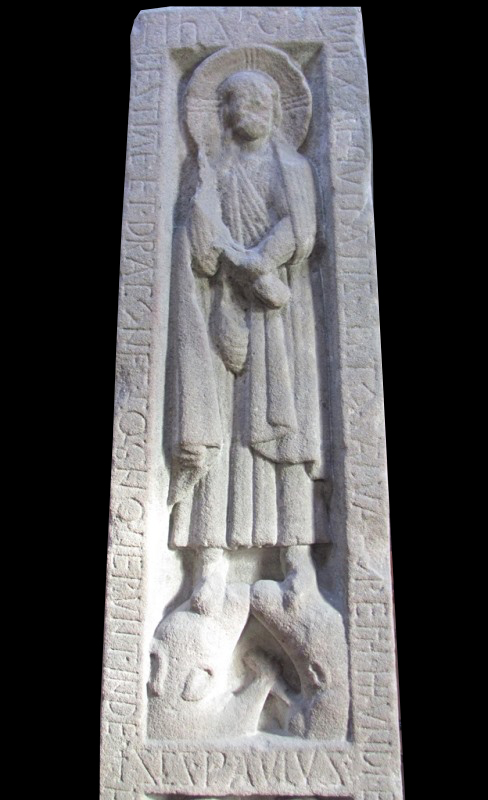In the early middle ages, Christian imagery often functioned beyond mere decoration.
Despite the iconoclastic controversy, the idea that images could serve as a “text” for the illiterate and the learned — was a widely used device in creating representations of the Christian doctrine. In this sense, images became multi-layered vehicles of devotion that could simultaneously communicate to the laypeople and members of the clergy. These instruments of faith sought to convey God’s word through imagery that would be recognizable to the uneducated population as instructional tools for conversion to Christianity. At the same time, these visual programs could serve as icons for reflection and meditation for the pious monks, spending their days in spiritual contemplation.
During the ninth and tenth centuries, developments in such artistic communications intensified, in part due to the ongoing controversy over iconoclasm. In creating Christian monuments, visual messages began to promote education or introspection instead of idolatry, leading to the evolution of new modes of symbolic communication.
One such monument is the Ruthwell Cross (c. late 7th early 8th century) in Scotland. The Ruthwell Cross is closely related to the contemporary Irish high crosses, and both are examples of the Insular art tradition. In this case, the object uses imagery to convey a story for the viewer to contemplate. This viewer could interpret their meanings depending upon the layer of storytelling directly engaging him. For example, a monk contemplating The Ruthwell Cross would be knowledgeable of the Biblical text inscribed within the imagery of the Cross. The Latin text and carved reliefs of Saints Paul and Antony in the desert speak to the particular reader of these cross sets. The complex interlocking of scenes that all point to the desert harkens back to the idea of spiritual living in the desert or wilderness, an essential tradition of monastic life during the early middle ages. Before St. Benedict’s guide to monastic life, written in 529, monasteries were located in remote areas such as the uninhabited wilderness or on islands. The monks would lead a solitary life, strengthening their faith and testing the resolve of their souls in imitation of the biblical stories. A learned monk meditating on this theme depicted on the Ruthwell Cross would remind himself of his vows and devotion to Christ.

Ruthwell Cross, 7th-8th century, Depicting scenes of “Jesus Christ: the judge of righteousness” and Saints Paul and Anthony in the desert, 18′ high, stone, Ruthwell, Scotland (previously Kingdom of Northumbria)
However, the Cross is bilingual, both figuratively and literally. Along with Latin is a carving of a second set of inscriptions in the runic language, which was the vernacular of the common people. Descendants of the invading tribes, such as the Visigoths and the Vikings, were now settled into the local population and were still predominantly pagan. Thus, the Cross, a public monument, could also serve as an educational tool to convert this segment of the community to Christianity. In addition to the dual language, the images themselves narrate illustrations of scenes from the life of Christ, which could further aid the local clergy in their instruction of the complex faith to the laypeople.
Additionally, it came to be known as a “speaking” cross. Interpretations of the runic inscription attribute it to an Old English poem where the narrator is “speaking to” the Cross of the Crucifixion. The inscription “says” that Christ and the Cross are one. This language may also relate to the design of the Cross itself, which depicts a circular motif in the center of the arms of the Cross, resembling the haloed figure of Christ beneath it, and possibly rendering the entire structure as a symbol for the crucified Christ. Once again, it utilizes the combination of image and text to explain a concept.
The Cross’s visual program directly infers the biblical themes of struggle and enlightenment in the solitude of the wilderness or desert. A humble setting, such as the rural countryside of Scotland, is succinctly aligned with the pure principles of Christianity unadulterated by political agendas. However, one should also consider the agenda of conversion when examining the purpose of the Ruthwell Cross. Conversion has, in its way, an agenda of power. It is essentially about one group’s system of belief exerting its ideals over another. When contemplating the Cross in this manner, it becomes more closely aligned to the lavish, expensive, and potentially politically charged monuments found in medieval Europe’s religious and political centers.
A constant duality occurs in the Ruthwell Cross, which manifests itself on many layers. When considering its setting, visual program, history, and methods of communication, the complexity of its purpose becomes an open-ended conversation regarding the history of religion, politics, and art. Perhaps this was the ultimate purpose of such a monument of faith; to leave the viewer constantly in a state of contemplation, reflecting on faith, power, and purpose.